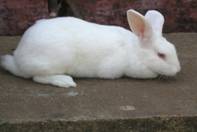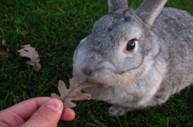
animal: Rabbit
Scientific name : Oryctolagus cuniculus
Common / Local Name :
 New Zealand White
New Zealand White
 Soviet Chinchilla
Soviet Chinchilla
Rabbit is a relatively a new introduction as a farm animal in our country and more particularly in this region. However, rabbit rearing is a gaining popularity for meat production and as a pet in this region very rapidly due to the following reasons:-
- It can be raised on roughage diet solely without affecting productive and reproductive performance. It indicates that it cannot compete with human beings for food grains like pig and bird.
- Its reproductive potentiality is very high i.e. rabbit can be bred around the year and gives at least four crops with five litters in each time, altogether 20 litters per doe per year.
- It is adaptable in wide range of climate and resistant to diseases.
- It can be marketed at 90 days of age.
- Rabbit meat is wholesome, tasty which is rich in protein, certain minerals and vitamins but low in fat and cholesterol.
- Â It fits very well in integrated farming system.
-
Out of four types of tested housing systems indoor cage housing was found to be best in respect of productivity.
-
Individual rearing is found to be better than group rearing in respect of productive and reproductive performance.
- Feed requirement for weaner - 50g, grower - 75g, finisher-100g, adult-125g and nursing mother 200g.
- Feed should contain at least 16-18 % CP and 10-12 % CF.
- Feed and fodder should be given twice daily
- Clean drinking water should be available round the clock
- As they are induced ovulator, throughout the year they can be bred.
- Age of breeding in male and female is 7 and 6 months.
- Selective breeding should be practiced and selection should be done on growth and carcass traits in male and on litter size at birth and litter weight at birth in female.
- Breeding at hot part of the day should be avoided.
- Weaning should be done at the age of 6-7 weeks. To overcome weaning stress one course of deworming by Sulmet and one course of Ostocalcium feeding is necessary.
- After weaning sexing and identification is needed.
- To avoid kit mortality, material of nest box is to be kept clean and dry. During night, light arrangement is also essential.
- To avoid mold infestation, feed is to be kept on dry, elevated place where entry of free air and light is possible.
- Age of slaughter and marketing should be 90-100 days as at this age best quality meat is available besides fur skin.
- As rabbit is sensitive to heat stress, hence during peak summer, they should be protected from direct sunlight either by providing shade, planting trees in and around the rabbit house.
-
Regular cleaning of shed, feeder and waterer is very essential to avoid digestive disorders.
-
Practically rabbit does not suffer from any major disease, hence no vaccination is needed.
-
They suffer from coccidiosis. Hence regular deworming is needed by anticoccidial medicine like sulmet etc. at least four times a year.Â
-
To avoid ricket problem one course of ostocalcium is needed after weaning.
-
In case of mite infestation neocidol or butox should be applied
Rabbit is basically animal of sub-temperate climate. Breeds for broiler rabbit production prefers ambient temperature of 15 -20 0 C and a relative humidity of 65 �5 %.
Four breeds were tested. Out of these New Zealand White and Soviet Chinchilla were found to be suitable breed for broiler rabbit production.
two to three times locally.
To avoid aflatoxicosis mold infested feed should be discarded and necessary treatment should be given immediately as per instruction of veterinarian.
Unit cost of production for Grower Rabbit � Rs 200/- each
Input availability |
Address/Contact details |
Incharge, Animal Science, ICAR-CCARI, Old Goa, Ela, Goa Director, ICAR-CCARI, Old Goa, Ela, Goa |
|
|
